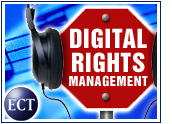
Microsoft yesterday pulled the wraps off the latest version of its digital rights management (DRM) software, a move awaited with great anticipation in some corners of the online music universe.
“We’re very excited about it,” Richard Bullwinkle, senior product marketing manager at Rio Audio in Santa Clara, California, told TechNewsWorld. “We believe it will lower the barriers for people who have wanted to enter portable [digital] music but have not jumped in.
“Some people say that they want portable music, but they don’t want to rip all their CDs,” he continued, “or they want portable music but they don’t want to purchase 10,000 songs for (US)$10,000.”
Renting Music
For makers of portable digital music players like Rio, Microsoft’s new DRM scheme, code-named Janus, contains some crucial elements of what they see as the future of their business.
“Janus will offer other pricing opportunities, such as renting music,” Bullwinkle said.
“This improved Windows Media DRM opens the door for Napster subscribers to increase their value by putting the music they’ve paid for through their subscription onto their digital players without having to pay again for each song,” added Chris Gorog, chairman and CEO of Roxio, parent company of Napster, in a statement.
Fights Digital Piracy
“Microsoft’s technology might be the biggest step forward in the fight against digital piracy and should catalyze the recurring revenue model for record labels and artists,” he said.
Right now, the dominant form of selling music online is pay-per-tune, or a la carte. But there’s a growing push — especially by music vendors that cater to the PC world — to attract more listeners to subscription services. Those services give music lovers unlimited access to music, but, until now, have severely restricted usage of the music.
Microsoft’s DRM scheme will broaden the usage options offered by subscription services through features like secure time clocks and metering and license chaining.
Enables Proof of Concept
Those features enable subscription services to let their customers transport music from the services to portable devices, according to Jason Reindorp, group manager for Microsoft’s Windows digital media division.
“There’s a lot of cooing and crowing about whether or not subscription services can be successful,” he told TechNewsWorld, “but I think you can’t even begin to answer that question until you have the device support we offer with this release.”
As long as you pay your monthly subscription fee, he explained, “you can treat the subscription content as you would in an a la carte situation.”
DRM Transparency
He noted that Microsoft not only tried to accommodate emerging developments like subscription services with this new DRM release, but also improved performance and transparency. “We’ve done a lot of things to make sure that the user never sees anything to do with DRM,” he observed.
In announcing its DRM scheme, Microsoft said in a statement that more than 20 companies are supporting it, including America Online, Disney, Napster, Samsung Electronics and Motorola.
“I can say that all of the companies supporting it are important, but … if I were a content provider, I would want to support Windows Media DRM because the newer version is going to be on the majority of computers around the world eventually,” Jarad Carleton, an IT industry analyst with Frost & Sullivan in Palo Alto, California, told TechNewsWorld via e-mail.
No Brainer
“For a content provider, it’s a no-brainer,” he added, “because one of the first things you want to do is avoid forcing consumers to download special players, because they don’t want to do that. So, as a content provider, if you can utilize Windows Media Player with Windows Media DRM built in, that is an advantage.”
Some analysts were underwhelmed by the support behind the Microsoft initiative.
“It’s nice to see [Microsoft] adding functionality and signing up people to create devices around the technology, but I don’t think it would qualify as a giant leap forward for rights management,” Ray Wagner, a research director at Gartner in Stamford, Connecticut, told TechNewsWorld.
“You notice in the announcement that they don’t have any of the major content providers signing up,” he continued. “This is a proposed standard, perhaps, but not one that has the support of giants like Sony, Philips, MGM and Universal just yet.”






















































Hi
How do you get your own music a DRM code? If you compose and create your own stuff and then make MP3 file formats? Thanks